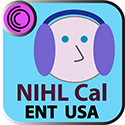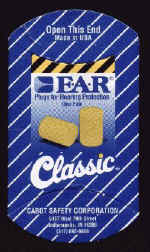The symptoms of noise induced hearing loss are
subtle in the early stages. Hearing loss tends to occur first for
high-pitched sounds only. Consequently, the volume of sound heard may be
unchanged but the quality of it lessens. Speech may be heard but not
completely understood. The presence of background noise can make speech
hard to understand. Noise induced hearing loss has been reported to be accompanied by a
ringing in the ears (tinnitus) in 23% of subjects (Phoon, 1993). Tinnitus can often be more annoying than
the hearing loss itself. Treatment of tinnitus is often unsatisfactory.
There has been an association between acoustic trauma (noise induced hearing loss) and
Meniere's disease which has been reported in the a few research
articles and text books.
However, more recent literature has shown that acoustic trauma is not a causative
factor --
Read More.
Decibel Levels of Environmental Sounds
| Source--Dangerous Level |
dBA SPL |
| 12-Gauge Shotgun |
165 |
| Produces Pain |
140 |
| Jet Engine During
Takeoff |
140 |
| Ambulance
Siren |
120 |
|
Discotheque/Chain Saw/Jackhammer |
110 |
| Tractor |
96 |
| Jackhammer
(at 15 m) |
95 |
| Lawn Mower |
90 |
| Heavy Truck
(at 15
meters) |
85 |
What Noises are Dangerous??
Physical measurements of the sound can be make
to determine whether it exceeds dangerous levels, and most factories have access
to the necessary equipment. Radio Shack also sells a sound level meter for
under $40 which will measure noise levels using the "A" Scale.
(This is what the designation dBA refers to -- decibels measured in the A
Scale.) However, without noise-measuring equipment,
the following basic rules can be followed:
#1. If it is necessary to shout to hear
yourself over a noise, the level of the sound can be damaging.
#2. Should ringing in the ears occur after
exposure to a loud sound, damage has been done and that sound should be avoided
or ear protection used in the future.
#3. If diminished hearing or a sense of
fullness in the ears is experienced after noise exposure, the level of
that noise is damaging. There are several federal
guidelines for noise exposure.
DHHS (NIOSH)
Publication No. 98-126 (
Download PDF )
"The NIOSH recommended exposure limit (REL) for occupational noise
exposure (85 decibels, A-weighted, as an 8-hour time-weighted average [85 dBA as
an 8-hr TWA]) was reevaluated using contemporary risk assessment techniques and
incorporating the 4000-hertz (Hz) audiometric frequency in the definition of
hearing impairment. The new risk assessment reaffirms support for the 85-dBA REL.
With a 40-year lifetime exposure at the 85-dBA REL, the excess risk of
developing occupational NIHL is 8%—considerably lower than the 25% excess risk
at the 90-dBA permissible exposure limit (PEL) currently enforced by the
Occupational Safety and Health Administration (OSHA) and the Mine Safety and
Health Administration (MSHA)."
NIOSH HEALTH HAZARD EVALUATION REPORT
HETA 95-0406-2609
"The OSHA standard for occupational
exposure to noise (29 CFR 1910.95)38 specifies a maximum PEL of 90
dB(A)-slow response for a duration of eight hours per day. The regulation, in
calculating the PEL, uses a 5 dB time/intensity trading relationship, or
exchange rate. This means for a person to be exposed to noise levels of 95 dB(A),
the amount of time allowed at this exposure level must be cut in half in order
to be within OSHA's PEL. Conversely, a person exposed to 85 dB(A) is allowed
twice as much time at this level (16 hours) and is within his daily PEL. NIOSH,
in its Criteria for a Recommended Standard,39 proposes an exposure
limit of 85 dB(A) for 8 hours, 5 dB less than the OSHA standard. In 1995, NIOSH
recommended a 3 dB exchange rate. In 1994, the ACGIH changed its TLV to a more
protective 85 dB(A) for an 8-hour exposure, with the stipulation
that a 3 dB exchange rate be used to calculate time-varying noise
exposures. Thus, a worker can be exposed to 85 dB(A) for 8 hours, but to only 88
dB(A) for 4 hours or 91 dB(A) for 2 hours." (ACGIH: American
Conference of Governmental Industrial Hygienists')
|
Duration of
Exposure (hrs/day)
|
Sound Level
dB(A)
|
|
ACGIH |
NIOSH |
OSHA |
|
16 |
82 |
82 |
85 |
|
8 |
85 |
85 |
90 |
|
4 |
88 |
88 |
95 |
|
2 |
91 |
91 |
100 |
|
1 |
94 |
94 |
105 |
|
1/2 |
97 |
97 |
110 |
|
1/4 |
100 |
100 |
115* |
|
1/8 |
103 |
103 |
--- |
|
|
*** |
|
** |
* No exposure
to continuous or intermittent noise in excess of 115 dB(A).
** Exposure to impulsive or impact noise should not exceed 140 dB peak
sound pressure level.
*** No exposure to continuous, intermittent, or impact noise in excess of a peak
C-weighted level of 140 dB.



